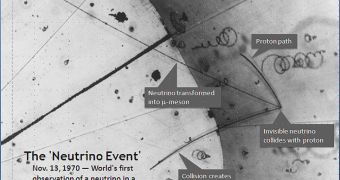For more than 20 years, a “rogue” theory in particle physics had it that a new type of elementary particle existed in the Standard Model, the current approach to explaining the basic particles around us.
But, after all these years, it would now appear that evidence to confirm the existence of this particle are beginning to mount, thanks to new investigations conducted in the United States.
Researchers at the Fermi National Accelerator Laboratory (Fermilab), working together with a professor at the University of Michigan believe they may have found evidence that a fourth flavor of neutrino exists, something the Standard Model does not allow for.
This high-profile experiment basically punches some holes in the only model physicists have been working on to explain the way the Universe is set up for decades.
Neutrinos are very interesting elementary particles in themselves. As the name suggests, they have a neutral electrical charge, and they always travel close to the speed of light.
They have the ability to pass through ordinary matter almost undisturbed, which makes them incredibly difficult to detect. Streams of the stuff pass through our planet every day, experts believe.
There are currently three known types of neutrinos, the counterparts of electrons, muons and taus. Once a particle of this type forms, it constantly undergoes a process called neutrino flavor oscillation,” which means that it changes flavors constantly.
In addition to describing a new type of neutrino, the new Fermilab experiments also demonstrated a flaw in the theory of the fundamental symmetry of the Universe.
Physicists at the lab now believe that antimatter particles behave pretty much in the same way as their regular matter counterparts do.
In spite of theories, the new research effort demonstrated that in a confined space more oscillations exist in neutrinos than would be possible if only three flavors existed for this particle.
The investigation was conducted in FErmilab's Mini Booster Neutrino Experiment (MiniBooNE).
“These results imply that there are either new particles or forces we had not previously imagined. The simplest explanation involves adding new neutrino-like particles, or sterile neutrinos, which do not have the normal weak interactions,” says expert Byron Roe.
He is a professor emeritus in the U-M Department of Physics, and also the author of a new paper describing the findings, which appears in the latest online issue of the esteemed scientific journal Physical Review Letters.
Funding for this investigation came from Fermilab, the US Department of Energy (DOE) and the National Science Foundation (NSF).

 14 DAY TRIAL //
14 DAY TRIAL //